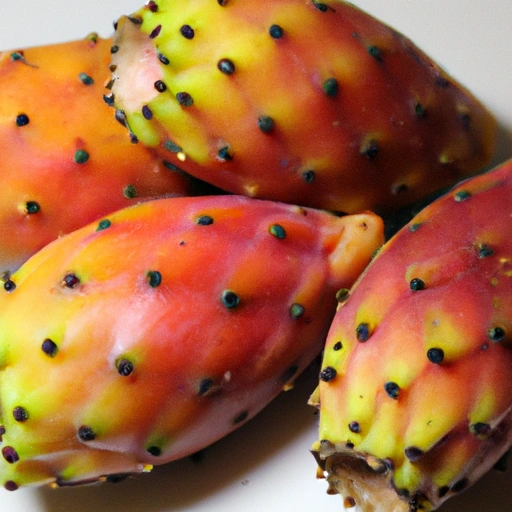Prickly Pear
Description

Prickly pear, also known as cactus fig or Opuntia, is the edible fruit of the cactus species commonly found in the Americas. It is characterized by its oval shape, vibrant colors ranging from green to reddish-purple, and its unique, sweet flavor. The fruit is covered with small prickles, which should be handled carefully or removed before consumption. Internationally, it is known by various names including 'tuna' in Spanish, and 'fichi d'India' in Italian.
Common uses
Prickly pear is often consumed fresh, made into juices, jams, or alcoholic beverages, and used as a natural sweetener or flavoring agent in culinary preparations. The fruit is also popular in candies and desserts, while the leaves of the cactus, known as nopales, are commonly cooked and eaten as a vegetable.
Nutritional value
Calories
A 100 gram serving of prickly pear contains approximately 41 calories (172 kilojoules).
Protein
This fruit provides about 0.7 grams of protein per 100 grams.
Fat
Prickly pear is low in fats, with a content of roughly 0.5 grams per 100 grams.
Carbohydrates
Carbohydrates are present at about 9.57 grams per 100 grams, primarily from natural sugars and dietary fiber.
Vitamins
It is a good source of Vitamin C, with about 14 mg per 100 grams, and also contains Vitamin B6, Vitamin A, and riboflavin.
Minerals
Prickly pear provides essential minerals such as calcium (56 mg per 100 grams), magnesium (85 mg per 100 grams), and potassium (220 mg per 100 grams).
Health benefits
Prickly pear is revered for its potential antioxidant properties, contribution to a healthy diet due to its fiber content, and vitamins that support immune function. It is also suggested that the fruit has anti-inflammatory effects and can aid in blood sugar regulation.
Potential risks
Due to its spines and glochids, improper handling can lead to skin irritation. Overconsumption may cause stomach issues in some individuals, and those with fructose intolerance should consume it in moderation.
Common recipes
Prickly pear is used in a variety of recipes, from refreshing smoothies and sorbets to savory sauces and chutneys. It can also be found in salads and as a topping for desserts.
Cooking methods
While often eaten raw, prickly pear can be grilled, pureed or incorporated into baked goods.
Pairing with other ingredients
Its sweet and slightly tart flavor pairs well with citrus fruits, herbs like mint and cilantro, and proteins such as pork and fish.
Summary
Prickly pear is a unique and versatile fruit that offers a range of culinary possibilities and health benefits. With its rich history and colorful presence, it adds both visual appeal and distinct flavor to dishes around the world.